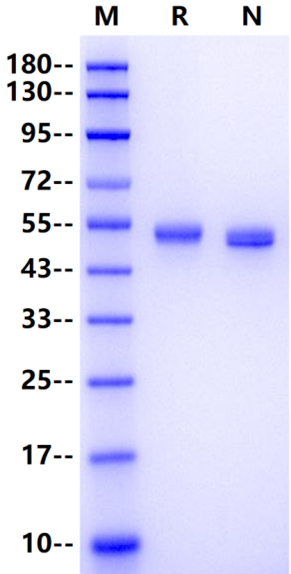Gln38-Asp414, with C-terminal 8*His QRLPRMQEDSPLGGGSSGEDDPLGEEDLPSEEDSPREEDPPGEEDLPGEEDLPGEEDLPEVKPKSEEEGSLKLEDLPTVEAPGDPQEPQNNAHRDKEGDDQSHWRYGGDPPWPRVSPACAGRFQSPVDIRPQLAAFCPALRPLELLGFQLPPLPELRLRNNGHSVQLTLPPGLEMALGPGREYRALQLHLHWGAAGRPGSEHTVEGHRFPAEIHVVHLSTAFARVDEALGRPGGLAVLAAFLEEGPEENSAYEQLLSRLEEIAEEGSETQVPGLDISALLPSDFSRYFQYEGSLTTPPCAQGVIWTVFNQTVMLSAKQLHTLSDTLWGPGDSRLQLNFRATQPLNGRVIEASFPAGVDSSPRAAEPVQLNSCLAAGDGGGSHHHHHHHH
1. Supuran CT. Carbonic anhydrases: novel therapeutic applications for inhibitors and activators. Nat Rev Drug Discov 2008;7:168-81.
2. McDonald PC, Swayampakula M, Dedhar S.. Coordinated regulation of metabolic transporters and migration/invasion by carbonic anhydrase IX. Metabolites 2018;8:E20.
The CAIX works as a dimeric molecule composed of two monomeric proteins liked with a disulfide bond between cysteine residues of the two CAIX monomers, while the structure of CAXII is stabilized by 19 hydrogen-bonded interactions in the dimer interface. Carbonic anhydrases IX and CAXII (CAIX/CAXII) are transmembrane zinc metalloproteins that catalyze a very basic but crucial physiological reaction: the conversion of carbon dioxide into bicarbonate with a release of the proton. CAIX functions with bicarbonate transporters (including electroneutral bicarbonate transporter NBCn1 (SLC4A7)) to bring in HCO3- produced in a CAIX-mediated hydration reaction of CO2, and amino acid transporters (including the large neutral amino acid transporter 1 (LAT1) and CD98 heavy chain (CD98hc)) to transport in essential amino acids and glutamine (via interaction with glutamine transporter SLC1A5 and sodium-coupled neutral amino acid transporter 2 (SNAT2) facilitating the uptake of amino acid by SLC1A5), which cancer cells employ as an alternative metabolic energy source and biosynthetic precursor. CAIX also creates unique interactions with collagen- and laminin-binding integrins at the leading edge of migrating cells.

Immobilized Carbonic Anhydrase IX/CA9 His Tag, Human (Cat. No. UA010533) at 2.0μg/mL (100μL/well) can bind Carbonic Anhydrase 9 Recombinant Rabbit mAb (starter-bio, Cat. No. S0B2289) with EC50 of 1.15-1.39 ng/mL.

1μg (R: reducing conditions, N: non-reducing conditions).